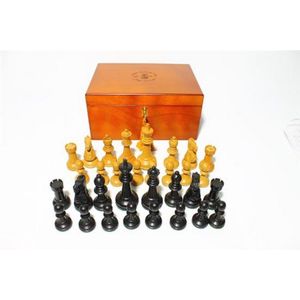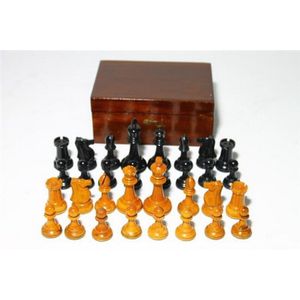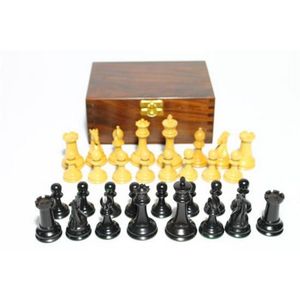House of Staunton Chess Set in Timber Case
You must be a subscriber, and be logged in to view price and dealer details.
Subscribe Now to view actual auction price for this item
When you subscribe, you have the option of setting the currency in which to display prices to $Au, $US, $NZ or Stg.
- Ebony - Ebony is a close grained timber, black in colour. It has a fine texture which can be polished to a high gloss, making it suitable for venereering, inlay and stringing and its use as solid timber is resticted to small decorative items and ornamental decoration, such as chess pieces and musical instrument parts. The term "ebonised" means "faux ebony", timber that has been darkened during the polishing process to resemble ebony.
- Staunton Chess Set - How should the king, queen, rooks and other pieces be depicted? Why is the king always the tallest piece and have a cross on his head. And why is the knight depicted as a horse head?
Until the adaption of a standard design, the designs of the pieces in every set varied. The Staunton chess set set a standard design for each piece used in the game of chess, and was the style adopted for use in chess competitions.
The Staunton designs were developed in 1849 and sold by sports and games manufacturers Jaques & Son of London, and were either designed by the proprietor of the firm, John Jaques or his his brother in law, Nathaniel Cook.
The design was named after Howard Staunton, an English chess player who was regarded as the leading player in the 1840s to 1850s.
The style has been popular for more than 160 years, and is still the standard today in tournament chess games and competitions. - Boxwood - Boxwood is a hard, yellow coloured, close grained timber. In the 19th century it was often used for inlays, especially stringing, because of its contrasting colour to the darker timbers of the carcase. Stringing is the inlay of a narrow strip of veneer of a lighter colour, such as boxwood along or close to the edges of an object that has been veneered in a darker timber such as mahogany.
Because of its fine grain and resistnce to splitting or chipping it has also been used for treen, turnings, carvings and other small wooden items, such as chess pieces.
This item has been included into following indexes:
Visually similar items

Turned timber chess set in house of Staunton box, King: 10 cm. Provenance: The collection of the late Dr Thomas James Valentine

Staunton chess set in timber box. Provenance: The collection of the late Dr Thomas James Valentine

19th century French natural and Burgundy stained ivory chess set, with carved and turned pieces, set within a box, height 9.5 cm

The rose' lead chess pieces, in red and black, in original box, King: 5 cm. Provenance: The collection of the late Dr Thomas James Valentine
